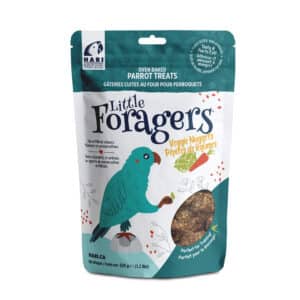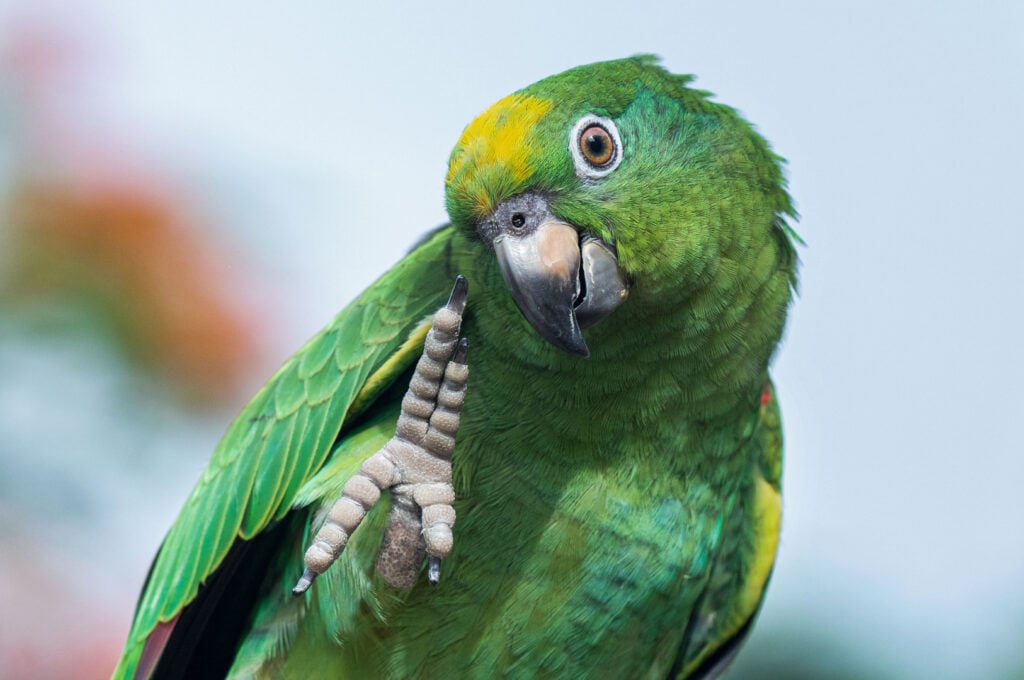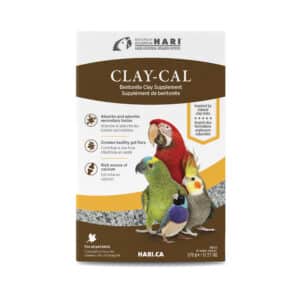Your cart is currently empty!
HARI Official Brand Site
Common Species
Orange winged (Amazona amazonica), Spectacled Amazon or White-fronted Amazon (Amazona albifrons), Blue fronted (Amazona aestiva), Yellow Crowned (Amazona ocrocephala ocrocephala) , Yellow-naped (Amazona ochrocephala auropalliata or Amazona auropalliata) Double Yellow Headed Amazon (Amazona oratrix or Amazona ochrocephala oratrix).
Origin/Habitat
Amazons can be found in the wild from northern Mexico to South America.
The Engaging Nature of Amazon Parrots
Comical, boisterous, playful, and outgoing, Amazon parrots have a well-earned reputation as being the “life of the party”. They thrive on love and attention and their charming personalities, coupled with their ability to mimic human speech, have made Amazon parrots popular as companion pets. Amazons are very social and highly intelligent, and as a result they require a lot of mental and social stimulation. They tend to do well in a family setting which can provide them with a lot of interaction. And while Amazons love interacting with people, they are very adaptable and are generally good at amusing themselves if given lots to do and toys to play with. There are many species of Amazons, each unique, and even those of the same species can have its own personality traits and quirks – but sharing your life with one of these amazing creatures is sure to be a delightful and rewarding experience.
The Amazona genus is home to the largest group of parrots, with 35 species in total. Some of these species, like Tucuman (Amazona tucuman) and Saint Vincent Amazon (Amazona guildingii), are quite rare in captivity, while others are more popular as pets. The most commonly kept species include Orange-winged Amazon, Spectacled Amazon or White-fronted Amazon, Blue-fronted Amazon, Yellow Crowned, Yellow-naped, and Double Yellow Headed Amazon.
Amazons are spread across a vast range, from northern Mexico to South America and there are nine species of amazons located in the Caribbean islands. In their natural habitat, amazons are typically active during two periods of the day: from dawn to mid-morning, and from mid-afternoon to dusk. These birds also prefer to live together in groups, foraging on seeds and fruits when hunting for food.
Amazon parrots are known for their long lifespan, ranging from 30 to 50 years on average, but they are also capable of living well beyond that.
Health Booklet
Keeping track of bird health by recording their growth, development, behavior and environment in a booklet can help ensure that your companion parrot will be healthy and happy for many years to come.
Physical Description
Amazons are stocky birds with square tails. Depending on the species, Amazons measure 25-40 cm (10 to 16 inches) in length.


They are mostly green with yellow, orange, blue, red, or white on their heads, wings and tails. The gender of most amazons is difficult to determine by physical characteristics alone, although in most species’ males are larger than females. A few species, when mature, such as Tucuman (Amazona tucumana) and Spectacled (White-fronted) are dimorphic as the males have more red primary coverts than the females.
They thrive on love and attention and should be considered part of the family.
Sex
The gender of most amazons is difficult to determine by physical characteristics alone, although in most species’ males are larger than females. A few species, when mature, such as Tucuman and Spectacled (White-fronted) are dimorphic as the males may have more red primary coverts.
DNA Testing is a reliable and safe way determine the sex of all other Amazon parrots. This procedure can be performed by an avian veterinarian or qualified avian specialist.

Personality Traits & Behaviors
Amazons are very outgoing, active birds. It has been said that if amazons were people, they would be a street smart, life of the party type person. While amazons love interacting with people, they are also very adaptable and are generally good at amusing themselves if given lots to do. They love playing with toys and are very enthusiastic chewers.

Noise Level/Speech/Song
Amazons can be very loud birds especially in the mornings and evenings.
Amazons are known for their talking ability, and most will become accomplished mimics as well as learn to sing and whistle.

Intelligence & Learning
Amazon parrots are highly intelligent and renowned talkers. As a result, they require a lot of mental stimulation. They are prone to behavioral problems without proper attention and social interaction.

Threats/Conservation
Amazons are critically endangered primarily due to habitat loss. While most parrots in the pet industry are considered aviary bred, many populations of Amazon parrot species in the wild are considered threatened or even endangered.

Relationship with Humans
Amazons are typically energetic. As a result, they love human interaction and require a large variety of toys. Even if they develop a closer bond with a family member, they can easily interact with new faces.
It is important to pay close attention to their behaviour, considering it is one of their methods of communication. This will help understand when they want to play, interact with others, or simply be left alone. If you are home frequently and can give your pet plenty of attention a single bird may do very well.
…they love human interaction and require a large variety of toys.
Care
The general rule of thumb when buying a bird cage is to buy the largest cage you can afford. For optimum health and safety, the cage should be at least two and a half times the width of the birds’ wingspan in all directions. Cage bar spacing should never be so wide that your bird could stick his head through, and his tail feathers should not be able to touch the bars when he is perched comfortably. Also consider your bird’s beak strength to determine the proper gauge of the bars as some birds have been known to bend the bars and escape.
A rectangular cage with horizontal bars in which your bird has plenty of room to climb and play is the best environment for your parrot. Your parrot will be happiest in a well-ventilated room with as much natural light as possible, yet away from direct sunlight and drafts. Your bird will want to be part of the action but not right in the middle of it. Avoid placing your bird’s cage in the kitchen as there are many hazards including vapors from heated PTFE coated pans (PTFE is better known as TeflonTM), hot stoves, pots of boiling water, and cooking fumes all of which can be very harmful to your bird. The cage and accessories should be thoroughly cleaned and disinfected weekly. Make sure your bird stays healthy by providing them with fresh food and water every day. Don’t forget to wash their dishes daily!
Time out of the cage every day for socialization and exercise is important. Parrots enjoy supervised activities on a play gym loaded with their favorite toys and enrichment food. Make sure he does not have access to open doors or windows, toilets with the lid up, hot stoves, moving ceiling fans or large panes of glass. It’s also a good idea to ensure he does not chew on or ingest anything unsafe such as treated or painted wood or unsafe house plants. Do not keep your bird in a room where sprays such as perfume, hair spray, air fresheners or aerosol sprays are used frequently.
For the safety of your beloved parrot, we advise against leaving them unattended with other pets like dogs, cats, or ferrets.
When it comes to feeding your Amazon, there are countless opinions to consider. Here’s what we believe: a high-quality extruded diet – such as Tropican – serves as the foundation of your parrot’s diet, while other healthy enrichment foods provide welcome variety.
Pelleted bird food is the ideal source of nutrition to keep your parrot healthy. However, it’s important to offer variety, too, gourmet seeds, dried fruits, vegetables, and nuts (such as Tropimix), beans, and fresh fruits and vegetables all provide essential nutrients and diversity to your parrot’s diet. Sensible, healthy table foods such as cooked pasta, rice, hard-boiled eggs, multigrain toast, and unsalted crackers can also serve as treats in small amounts.
It is crucial to avoid unhealthy people foods. Never feed your parrot chocolate, alcohol, caffeine beverages, or avocado as even small amounts can be toxic. Salty or sugary foods should also be avoided. Check out our feeding recommendations for most parrot species.
Of course, fresh water every day is very important too. Remember to wash and refill your parrot’s water bowl daily to keep your bird healthy and happy.
Amazons need ten to twelve hours of uninterrupted sleep per night. If your bird cage is normally situated in a room where there is a lot of activity or movement, it is best to move it to a secluded dark area at night. Sleep is a vital to an Amazon’s well-being.
Many bird owners will cover the bird cage at night to help block out extra light (especially during the summertime). A cover can also keep the cage warmer (for those living in colder climates).
Placing a comfortable perch higher up in the cage will give them a sense of security and keep their feet healthy. If you do not plan on covering the cage or if the bird suffers from night terrors try using an infrared basking light or small night light in the room.
Amazons need a variety of perch types and sizes. Improperly sized or dirty perches contribute to Pododermatitis or Bumblefoot. Offer your bird at least three types of perches appropriately sized for his feet: cotton or sisal rope; natural wood perches with a variety of diameter. Keep perches clean and if you use cotton or sisal rope, check frequently for signs of loose strands. Often perches will need to be replaced due to normal wear and tear. If a grooming perch is utilized, please avoid placing this perch at the highest level of the cage nor place it near food and water stations.
Amazon Parrots are energetic birds that require a wide range of toys to keep them engaged and active. Swings, climbing ropes, and ladders are all great options to promote movement and exercise. To avoid boredom, it is recommended to rotate toys every one or two weeks.
HARI Smart.Play bird toys are an excellent choice as they stimulate various activities and functions. These toys are divided into different groups: foraging, foot & audio, preening, exercise, and perching.
Foraging toys are perfect for mental and physical stimulation, anxiety relief, and entertainment. This type of toy is particularly useful when a bird is new to its environment and needs a way to channel its anxiety.
Foot & Audio Enrichment Toys are an excellent addition to any bird toy collection. They promote curiosity and entertainment, while also developing balance, dexterity, and strength in birds.
If your parrot is often alone, preening toys are especially important. They help relieve boredom, promote mental and physical stimulation, and prevent feather damaging behaviors in birds.
Basic commands such as “step up” and “step down” are essential for every companion parrot to learn. To ensure that your parrot is well-trained, it’s crucial to be consistent with the step-up command each time you pick them up. It’s important to make sure that your parrot follows through with the command when given; otherwise, you’re not reinforcing good behavior. A well-trained parrot will often stick their foot out when they see you extend your hand, usually before being asked to step up.
Teaching more advanced commands to companion parrots can be a great way to provide mental stimulation and strengthen the bond between you and your feathered friend. Encourage your parrot to spin in a circle by using a treat or toy as a lure. Once they start to turn, give the command “turn around” and reward them when they complete the full spin. Add in a wave, teach your parrot to wave hello or goodbye by holding up your hand and saying “wave.” Use a treat as a reward when they lift their foot or wing in response.
Remember to always use positive reinforcement techniques when training your parrot and to keep training sessions short and frequent. With patience and consistency, your parrot can learn a wide range of fun and useful commands.
Amazons are native to the rainforest and are well-suited to those conditions. In captivity, daily bathing is essential for their overall health and well-being, especially in dryer climates, as it helps to moisturize their nasal passages, feet, and feathers while keeping their skin in excellent condition. If your bird is hesitant to bathe on their own, use a spray bottle with warm water to mist them gently or provide them with a shower perch. Before misting, remove seeds or pellets from their cage, as damp food can attract mold and bacteria. Always bathe your bird early in the day and allow them to dry naturally in a draft-free area.
Did you know that birds, including Amazons, have veins that extend to the end of their nails? To avoid bleeding, we recommend trimming your bird’s nails during their semi-annual check-ups with a veterinarian. If you’re considering managing your bird’s flight feathers by trimming their wings, it’s best to have someone experienced do it for you. This is because accidentally cutting a blood feather is a possibility if you’re not familiar with what to look for. Keep in mind, flight feather management or wing trimming does not guarantee that your bird won’t be able to fly. Even one or two grown-in feathers can give them the ability to take off. That’s why it’s important to never take your bird outside without a secure cage or a properly fitted bird harness.
If you’re a parrot owner, you’ll want to ensure that your feathered friend has the longest lifespan possible. This means creating a safe and secure environment, safe from the following common household dangers: Non-stick surfaces (such as PTFE coated pans), oven cleaner and self-cleaning ovens, cigarette smoke, paint and paint fumes, scented candles, household cleaners, floor polish, hairspray, chlorine bleach, perfume, aerosol sprays, nail polish and nail polish remover fumes and ingesting harmful or toxic house plants. Be sure to inform everyone in your household of the potential toxicity of certain foods and products, such as avocados, chocolate, coffee beans, onions, salt, and fruit seeds or pits. Keep in mind that ceiling fans, cupboards, blinds, and open doors and windows can also pose a risk as your pet may fly into, get trapped or simply fly away.
As a responsible pet owner, it is important to keep your Amazon healthy and happy. Regular veterinary check-ups can help detect any potential health problems before they become major issues. Semi-annual health check-ups should include a physical examination, grooming, and necessary laboratory tests. While some clinics can provide routine bird appointments, it’s recommended to consult a certified avian veterinarian for more complex cases. These professionals can offer valuable advice on appropriate health care for your parrot, ensuring that your feathered friend stays healthy and happy for years to come.
Availability in the Pet Market
Amazon Parrots can be obtained from many sources, including avian specialty stores, pet dealers, and reputable breeders. You can also explore online adoption organizations and rescue groups as alternative options.

Aviculture
Breeding Habits
In the wild, the onset of sexual maturity varies depending on the species, but the average age is around four years old . Breeding season can differ by species, but it usually occurs between late August and December when food sources are abundant. Clutch size is typically 2-3 eggs in most species.
Reproductive Maturity
In captive settings, the breeding season is typically more regimented and brief, depending on the environment. For outdoor facilities in warmer areas, the breeding season lasts from early spring until mid-summer. With indoor or climate-controlled aviary settings, altering the number of full-spectrum lights and length of day can initiate the season. While certain Amazon species may reach sexual maturity and produce chicks at three years old, the average age range is more often five to six years old.
Hatchling to Fledgling
Most aviculturists catering to the pet bird trade prefer to have parent birds raise their young for about two to three weeks before beginning hand feeding. Breeding parrots should be in optimal health and receive proper nutrition to support the needs of both the “expectant” parents and the nestlings. Tropican High Performance 4mm, 8mm, Sticks and Tropimix Small & Large Parrot are excellent options, as well as vegetables and fruits high in beta-carotene to meet the nutritional needs of breeding parrots. Adding Prime Vitamins to the diet can also benefit breeding pairs on a predominately seed-based diet.
Suggested Products

Smart.Play
Corn Silk Cascade, Large, Enrichment Parrot Toy for Medium to Large Birds
Enrichment Parrot Toy for Medium to Large Birds
Made in Canada





